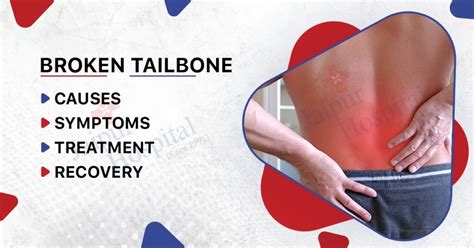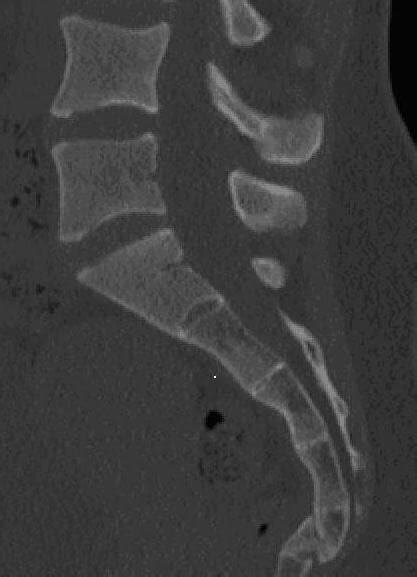Intro
Identify bruised tailbone symptoms, including pain, numbness, and limited mobility. Learn about coccydynia, tailbone injury, and treatment options for a bruised coccyx.
A bruised tailbone, also known as a coccyx bruise or coccydynia, can be a painful and uncomfortable condition that affects many people. The tailbone, or coccyx, is the triangular bony structure located at the bottom of the spine. It is a common area for bruising and injury, especially in individuals who have fallen onto their buttocks or experienced a direct blow to the area. In this article, we will delve into the symptoms, causes, and treatment options for a bruised tailbone, providing you with a comprehensive understanding of this condition.
The symptoms of a bruised tailbone can vary in severity and duration, depending on the extent of the injury. Some common symptoms include pain and discomfort when sitting, standing, or walking, as well as tenderness and bruising in the affected area. In more severe cases, individuals may experience numbness, tingling, or weakness in the legs, as well as difficulty controlling bowel movements or urination. It is essential to seek medical attention if you are experiencing any of these symptoms, as a bruised tailbone can be a sign of a more serious underlying condition.
In addition to the physical symptoms, a bruised tailbone can also have a significant impact on daily life. Simple activities such as sitting, driving, or exercising can become challenging and painful, leading to frustration and discomfort. Furthermore, the emotional and psychological effects of a bruised tailbone should not be underestimated, as the condition can cause feelings of anxiety, depression, and isolation. By understanding the symptoms and causes of a bruised tailbone, individuals can take the first step towards seeking treatment and finding relief from this painful condition.
Bruised Tailbone Causes

A bruised tailbone can be caused by a variety of factors, including falls, direct blows, and repetitive strain. Falls onto the buttocks or tailbone area are a common cause of bruising, especially in individuals who participate in sports or activities that involve jumping, landing, or rapid changes of direction. Direct blows to the tailbone, such as those experienced in a car accident or physical altercation, can also cause bruising and injury. Repetitive strain, such as prolonged sitting or standing, can also lead to a bruised tailbone, especially in individuals who have poor posture or engage in activities that involve repetitive bending or twisting.
Other causes of a bruised tailbone include obesity, poor posture, and certain medical conditions, such as osteoporosis or rheumatoid arthritis. In some cases, a bruised tailbone can be a sign of a more serious underlying condition, such as a fracture or dislocation of the coccyx. It is essential to seek medical attention if you are experiencing any symptoms of a bruised tailbone, as prompt treatment can help to alleviate pain and prevent further complications.
Bruised Tailbone Symptoms and Diagnosis

The symptoms of a bruised tailbone can vary in severity and duration, depending on the extent of the injury. Common symptoms include:
- Pain and discomfort when sitting, standing, or walking
- Tenderness and bruising in the affected area
- Numbness, tingling, or weakness in the legs
- Difficulty controlling bowel movements or urination
- Pain or discomfort when coughing, sneezing, or straining
To diagnose a bruised tailbone, a healthcare professional will typically perform a physical examination and take a medical history. The examination may involve palpating the tailbone area to assess for tenderness and bruising, as well as evaluating the range of motion and strength of the surrounding muscles. Imaging tests, such as X-rays or MRI scans, may also be ordered to rule out more serious underlying conditions, such as a fracture or dislocation of the coccyx.
Bruised Tailbone Treatment Options

Treatment for a bruised tailbone typically involves a combination of self-care measures, medications, and physical therapy. Self-care measures may include applying ice or heat to the affected area, taking regular breaks to rest and stretch, and avoiding activities that exacerbate the condition. Medications, such as pain relievers and muscle relaxants, may be prescribed to help alleviate pain and discomfort.
Physical therapy can also be an effective treatment option for a bruised tailbone. A physical therapist can help to develop a customized exercise program to improve flexibility, strength, and range of motion, as well as provide education on proper posture and body mechanics. In some cases, more invasive treatments, such as corticosteroid injections or surgery, may be necessary to alleviate pain and promote healing.
Bruised Tailbone Prevention

Preventing a bruised tailbone requires a combination of proper posture, body mechanics, and safety precautions. Individuals can reduce their risk of developing a bruised tailbone by:
- Maintaining good posture and avoiding slouching or bending
- Engaging in regular exercise to improve flexibility and strength
- Wearing protective gear, such as a helmet or pads, when participating in sports or activities
- Avoiding repetitive strain and taking regular breaks to rest and stretch
- Maintaining a healthy weight and avoiding obesity
By taking these precautions and being mindful of their body position and movements, individuals can reduce their risk of developing a bruised tailbone and promote overall health and well-being.
Bruised Tailbone Complications

If left untreated, a bruised tailbone can lead to a range of complications, including chronic pain, limited mobility, and decreased quality of life. In some cases, a bruised tailbone can also lead to more serious underlying conditions, such as a fracture or dislocation of the coccyx. It is essential to seek medical attention if you are experiencing any symptoms of a bruised tailbone, as prompt treatment can help to alleviate pain and prevent further complications.
Other potential complications of a bruised tailbone include:
- Chronic pain and discomfort
- Limited mobility and decreased range of motion
- Decreased quality of life and overall well-being
- Increased risk of developing more serious underlying conditions, such as a fracture or dislocation of the coccyx
By understanding the potential complications of a bruised tailbone, individuals can take the first step towards seeking treatment and finding relief from this painful condition.
Bruised Tailbone Prognosis

The prognosis for a bruised tailbone is generally good, with most individuals experiencing significant improvement in symptoms within a few weeks of treatment. However, the prognosis can vary depending on the severity of the injury and the effectiveness of treatment. In some cases, a bruised tailbone can lead to chronic pain and limited mobility, especially if left untreated or undertreated.
Factors that can affect the prognosis of a bruised tailbone include:
- Severity of the injury
- Effectiveness of treatment
- Presence of underlying medical conditions
- Overall health and well-being of the individual
By understanding the factors that can affect the prognosis of a bruised tailbone, individuals can take the first step towards seeking treatment and finding relief from this painful condition.
Bruised Tailbone Recovery Time

The recovery time for a bruised tailbone can vary depending on the severity of the injury and the effectiveness of treatment. In general, most individuals can expect to experience significant improvement in symptoms within a few weeks of treatment, with full recovery taking several months.
Factors that can affect the recovery time of a bruised tailbone include:
- Severity of the injury
- Effectiveness of treatment
- Presence of underlying medical conditions
- Overall health and well-being of the individual
By understanding the factors that can affect the recovery time of a bruised tailbone, individuals can take the first step towards seeking treatment and finding relief from this painful condition.
Bruised Tailbone Exercises

Exercises can be an effective way to promote healing and alleviate pain in individuals with a bruised tailbone. Gentle stretching and strengthening exercises can help to improve flexibility and range of motion, while also reducing pain and discomfort.
Some examples of exercises that may be helpful for a bruised tailbone include:
- Pelvic tilts: Lie on your back with your knees bent and feet flat on the floor. Tilt your pelvis upwards and then back down again, repeating the motion for several repetitions.
- Knee to chest stretch: Lie on your back and bring one knee towards your chest. Hold for several seconds and then repeat on the other side.
- Bridging: Lie on your back with your knees bent and feet flat on the floor. Slowly lift your hips towards the ceiling, squeezing your glutes and lower back muscles as you lift.
By incorporating these exercises into your daily routine, you can help to promote healing and alleviate pain in your bruised tailbone.
What are the symptoms of a bruised tailbone?
+The symptoms of a bruised tailbone can include pain and discomfort when sitting, standing, or walking, as well as tenderness and bruising in the affected area. In more severe cases, individuals may experience numbness, tingling, or weakness in the legs, as well as difficulty controlling bowel movements or urination.
How is a bruised tailbone diagnosed?
+A bruised tailbone is typically diagnosed through a physical examination and medical history. Imaging tests, such as X-rays or MRI scans, may also be ordered to rule out more serious underlying conditions.
What are the treatment options for a bruised tailbone?
+Treatment for a bruised tailbone typically involves a combination of self-care measures, medications, and physical therapy. Self-care measures may include applying ice or heat to the affected area, taking regular breaks to rest and stretch, and avoiding activities that exacerbate the condition.
Can a bruised tailbone be prevented?
+Yes, a bruised tailbone can be prevented by maintaining good posture, engaging in regular exercise, and wearing protective gear when participating in sports or activities. Individuals can also reduce their risk of developing a bruised tailbone by avoiding repetitive strain and taking regular breaks to rest and stretch.
What are the potential complications of a bruised tailbone?
+If left untreated, a bruised tailbone can lead to a range of complications, including chronic pain, limited mobility, and decreased quality of life. In some cases, a bruised tailbone can also lead to more serious underlying conditions, such as a fracture or dislocation of the coccyx.
We hope this article has provided you with a comprehensive understanding of bruised tailbone symptoms, causes, and treatment options. If you are experiencing any symptoms of a bruised tailbone, we encourage you to seek medical attention and take the first step towards finding relief from this painful condition. Share this article with others who may be experiencing similar symptoms, and let's work together to promote awareness and understanding of this common condition.
